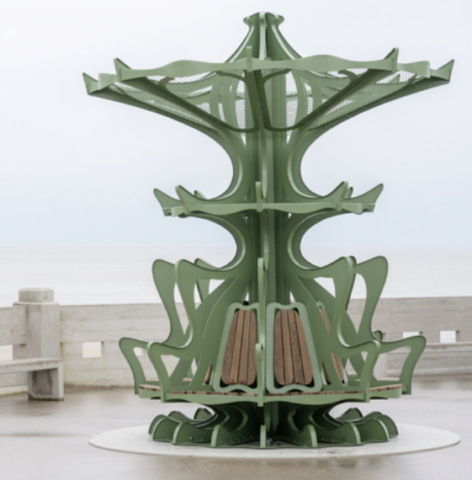Work; Together
By Jo Phillips
Gone are the days of the solitary artist emerging from the studio with a masterpiece created without the influence and input of others. Artists today are often working alongside others in their studios or sometimes in collectives, bringing their combined skills and experience to the table. The artists Florian Pugnaire and David Raffini have a collaborative practice that has received international recognition with exhibitions at Palais de Tokyo, Paris, and Centre Pompidou, Paris, which holds their work in its collection.
So we asked the French artists some questions about how they work together to gain an insight into their creative process in the wake of their new exhibition SHOW ME at L’étrangère, London.
How do you work collaboratively on projects, do you have different roles/specialisms?
We work on everything together. A project usually begins by one of us proposing an idea, which then evolves through conversations. We use the sharing of our technical skills to realise the project. For example, if one of us is skilled at mechanics, and the other is better suited to editing, the project easily becomes a film about a mechanical process. Anyway, in this kind of work, we are always learning new techniques, and at the end of the day, we both end up working on every part of the projects.
The works exhibited in SHOW ME are films that show the transformation and destruction of two vehicles. How and why do you choose the particular vehicles?
The choice of vehicle depends on several things. Sometimes its related to specific sculptural necessity — as with the old 2cv we used to make our first Expanded Crash. Here we needed a car made only of metal, without any fiberglass or plastic components, in order to be able to distort the surface. For the project Show Me, we also needed a car only made of metal. The Opel GT was absolutely perfect, because of its unibody construction (the entire body was made of a single metalic piece), and also because it was a well designed racing car with a bodyline that reminded us of a 70s American muscle vehicle. This would make it easy for us to draw reference to John Carpenter’s famous car movie Christine. The yellow truck we decided to use for Dark Energy on the other hand, we chose for the simple reason that it was our old studio truck. We had used it for years to transport different artworks and materials. When we realised that we needed a new one, we decided to make a movie using it; to turn it into a sculpture, rather than throwing it to a scrapyard.
How do you make the car mutate, technically?
For Dark Energy, we used a hydraulic device and pump, concealed inside of the vehicle’s passenger compartment. The cars’ contractions are the result of this onboard mechanism — hidden, so that the origin of the movement is not made visible. This allowed for the transformation of the car to come from within its structural form — here, the car appears to be alive, as though it were searching for its own sculptural shape. Depending on the project, the device is either digitally programmed, or manually operated.
How long is the process of creating a piece? The production values are very high.
The creative process can be long, or very short — it really depends on the project. For example, our first collaborative piece, Expanded Crash — a 2CV that slowly contracted for the duration of the exhibition —we worked for five months in a workshop in Corsica. At that time, we were not yet very familiar with hydraulic techniques, and we learned about it out of necessity. The work was particularly experimental, and it took shape before our eyes, evolving little by little.
Whether sculptures or films, production costs are also an issue — they are often relatively high, because of the price of the materials we use. For some specific materials such as hydraulic pumps and flexible metal, we often work with used, secondhand components that we spend time sourcing.
We also want to realise the projects by ourselves, without the help of outside companies or external stakeholders. This allows us to work on ambitious projects in the total economy of our own means.
The works seem very inspired by cinema, can you expand?
Whether it’s a video or sculpture, our collaborative works are often inspired by cinema. Our video works often reference quite explicitly cinematic scenes — both in the scenarios they depict, and styling of their image. We borrow from the aesthetics of 1980s B-movies (such as John Carpenter’s dark and fantastic atmospheres), and from filmmakers Stanley Kubrick and Andrei Tarkovski. I think that it’s in this mix of genres that our videos take on a distinct tone.
In general, our practice tends to highlight the process of making a work — in a film, this process is often transformed into a fictional story. When we don’t use the medium of video however, the work’s relationship with cinema takes on a different form. Our sculptures tend to borrow from the film’s main components, characterised by its relation to time, space, movement or light. The Wave, exhibited in the Jardin des Tuileries for FIAC 2017, made of 24 polished stainless steel sheets, successively aligned on two parallel rails, moved in succession like the flickering of those images that make up a single second of cinema. They materialise the impact of a shockwave in a sequence — a sequencing that bears a striking resemblance to chronophotography. The first sheet has an impact in its centre, which produced a violent deformation of the material. In its wake are twenty-three other plates that seem to gradually recover the sheet to its original form. The initial impact is passed from one plate to the other. The last, unscathed, gradually disappearing in an inexorable degressivity.
How do the sculptures relate to the film in the installation at L’étrangère?
The sculptures in the installation at l’étrangère, are directly linked to the videos shown alongside them. If we consider that vehicles are the characters of the films presented, the sculptures exhibited at the gallery could be secondary characters. These are objects that are seen evolving in the background, or appearing at a particular moment. So in Show Me, whilst the car is gradually changing, we can see around it, hanging on the walls, metal plates painted in the same colour as the body that creases gradually in the video.
The appearance of the plates in the film is done by ellipse, allowing the viewer to see a state of transformation given at a specific moment. By preparing several plates at different times of their transformation, this allowed us to interchange the plates when shooting. Those hung on the walls of the gallery are the different plates that represent only one shown in the film.
The metal sheet extracted from the video Dark Energy, on the other hand, does not evolve in the film. It is during the crazy race that the vehicle goes at full speed past a sculpture made of several sheets of sheets of metal, producing a violent gust that seems to activate the sculpture. The camera lingers for a moment on the sculpture of twisted metal plates that sway, mimicking the effect of the wind.
Is this quite different to other presentations you have exhibited, and how?
This installation is very different from the video-sculpture installations we have done previously. We usually show our films alongside sculptures made from the remnants of the vehicles we used in the film. For the first time, we decided not to show the truck or the car featured in the film, but to exhibit those objects appearing in the background. With the main characters of the films absent from the exhibition space, there is room for the secondary characters. The sculpture created by the film is allowed to extend beyond the metamorphosis of the main object (or subject).
Do you feel hopeful or the opposite about man’s technological advancement?
The relationship between man and machine is a fundamental question we must pose when considering the future of our society. Our current lifestyle and the acceleration of productivity we have experienced over the past decade have all been the result of this relationship — a relationship that has raised questions since the beginning of the industrial revolution.
The advent of the machine has brought on many anxieties in our societies — especially with respect to developments in artificial intelligence. It is therefore not a coincidence that our films refer to a certain genre of fantasy film or science fiction, in which the advent of the machine is often synonymous with a sort of deviance of humanity.
The objects we create tend to highlight, however, the dysfunction of technology — creating an absurd form of metamorphosis, dedicated to self-destruction. Our machines recall the myth of Sisyphus, similarly to the machines of Swiss sculptor Jean Tinguely, and testify to the absurdity of movements of mechanical repetition.
What exciting projects do you have coming up?
We are currently preparing two new projects. The first is to give new life to a sculpture that we created 3 years ago. This sculpture is a car that has self-compressed for the duration of several exhibitions, to such an extent that the process has now stopped. Today, we would like to reactivate the internal mechanism of the sculpture, to bring it back to life by creating a perpetual movement — something similar to that of breathing. It would be a sort of last breath, which would never stop, trapping the animated object between life and death. This project will be exhibited at Art Brussels 2018, with the gallery Ceysson and Benetière. The second project is the finalisation of a film that we shot last year on a residency in Los Angeles. This film, which takes its form as a “road movie” of sorts, features a character who collects fragments of ruins in a de-humanized world, driven by the need to make a final sculpture. This project will be shown, accompanied by a series of sculptures, in a solo exhibition at the Ceysson and Benetière gallery in Paris (September 2018).
Florian Pugnaire and David Raffini have successfully mastered the art of working collaboratively to push and develop their ideas as a team for each project. Their latest exhibition SHOW ME is on until 3 March 2018 at L’étrangère, London. The artists will be in conversation with curator Fatos Üstek at L’étrangère on Wednesday 28 February, 7 – 9 pm.
Words Jasmine Gauthier
L’étrangère, 44a Charlotte Road, London EC2A 3PD Find more information here
Florian Pugnaire and David Raffini – Dark Energy, 2012. HD video, 15 min © the artists. Courtesy l’étrangère
Florian Pugnaire and David Raffini – Expanded Crash (Show Me), 2016. HD video, 7 min 30 sec © the artists, Courtesy l’étrangère








